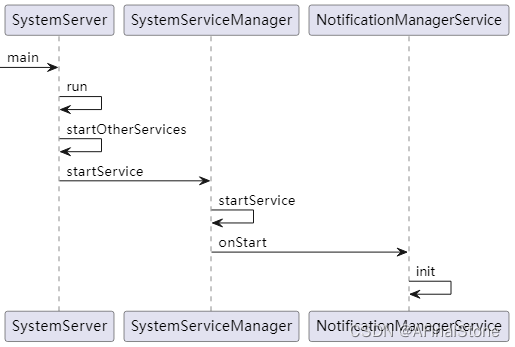前言
通知可以说是Android系统最常见的功能之一,大多数应用处于后台收到服务端推送消息的时候,都会触发系统状态栏通知来提醒用户特定的信息,而NotificationManagerService作为通知服务,和系统通知功能息息相关,要理解NotificationManagerService服务,自然要先知道它是如何诞生的,本篇文章我们将会具体梳理一下NotificationManagerService的启动流程。
一、SystemServer启动NotificationManagerService的服务
1、系统启动后会启动JVM虚拟机,SystemServer 是虚拟机的第一个进程,由init 进程fork 产生。主要用来启动frameworks层中的服务。SystemServer进程里面有个main()方法,main 方法如下:
frameworks/base/service/java/com/android/server/SystemServer.java
public final class SystemServer {
public static void main(String[] args) {
new SystemServer().run();
}
}
2、main 方法里启动了 run() 方法,而在 run 方法中调用了startOtherServices() 方法:
public final class SystemServer {
private void run() {
...
// Start services.
try {
traceBeginAndSlog("StartServices");
startBootstrapServices();//启动引导服务
startCoreServices();//启动核心服务
startOtherServices();//启动其他服务
SystemServerInitThreadPool.shutdown();
} catch (Throwable ex) {
Slog.e("System", "******************************************");
Slog.e("System", "************ Failure starting system services", ex);
throw ex;
} finally {
traceEnd();
}
...
}
}
3、startOtherServices方法和NotificationManagerService服务启动相关的代码如下所示。
public final class SystemServer {
private SystemServiceManager mSystemServiceManager;
private ActivityManagerService mActivityManagerService;
private void startOtherServices(@NonNull TimingsTraceAndSlog t) {
...代码省略...
traceBeginAndSlog("StartNotificationManager");
mSystemServiceManager.startService(NotificationManagerService.class);
SystemNotificationChannels.createAll(context);
notification = INotificationManager.Stub.asInterface(
ServiceManager.getService(Context.NOTIFICATION_SERVICE));
traceEnd();
...代码省略...
}
}
4、SystemServiceManager的startService方法如下所示:
frameworks/base/services/core/java/com/android/server/SystemServiceManager.java
public class SystemServiceManager {
/**
* Creates and starts a system service. The class must be a subclass of
* {@link com.android.server.SystemService}.
*
* @param serviceClass A Java class that implements the SystemService interface.
* @return The service instance, never null.
* @throws RuntimeException if the service fails to start.
*/
@SuppressWarnings("unchecked")
public <T extends SystemService> T startService(Class<T> serviceClass) {
try {
final String name = serviceClass.getName();
Slog.i(TAG, "Starting " + name);
Trace.traceBegin(Trace.TRACE_TAG_SYSTEM_SERVER, "StartService " + name);
// Create the service.
if (!SystemService.class.isAssignableFrom(serviceClass)) {
throw new RuntimeException("Failed to create " + name
+ ": service must extend " + SystemService.class.getName());
}
final T service;
try {
Constructor<T> constructor = serviceClass.getConstructor(Context.class);
service = constructor.newInstance(mContext);
} catch (InstantiationException ex) {
throw new RuntimeException("Failed to create service " + name
+ ": service could not be instantiated", ex);
} catch (IllegalAccessException ex) {
throw new RuntimeException("Failed to create service " + name
+ ": service must have a public constructor with a Context argument", ex);
} catch (NoSuchMethodException ex) {
throw new RuntimeException("Failed to create service " + name
+ ": service must have a public constructor with a Context argument", ex);
} catch (InvocationTargetException ex) {
throw new RuntimeException("Failed to create service " + name
+ ": service constructor threw an exception", ex);
}
startService(service);
return service;
} finally {
Trace.traceEnd(Trace.TRACE_TAG_SYSTEM_SERVER);
}
}
public void startService(@NonNull final SystemService service) {
// Register it.
mServices.add(service);
// Start it.
long time = SystemClock.elapsedRealtime();
try {
service.onStart();
} catch (RuntimeException ex) {
throw new RuntimeException("Failed to start service " + service.getClass().getName()
+ ": onStart threw an exception", ex);
}
warnIfTooLong(SystemClock.elapsedRealtime() - time, service, "onStart");
}
}
startService方法首先通过反射创建了NotificationManagerService对象,紧接着会调用NotificationManagerService的onStart方法。
二、NotificationManagerService启动
1、NotificationManagerService的onStart方法如下所示:
frameworks/base/services/core/java/com/android/server/notification/NotificationManagerService.java
public class NotificationManagerService extends SystemService {
@Override
public void onStart() {
SnoozeHelper snoozeHelper = new SnoozeHelper(getContext(), new SnoozeHelper.Callback() {
@Override
public void repost(int userId, NotificationRecord r) {
try {
if (DBG) {
Slog.d(TAG, "Reposting " + r.getKey());
}
enqueueNotificationInternal(r.sbn.getPackageName(), r.sbn.getOpPkg(),
r.sbn.getUid(), r.sbn.getInitialPid(), r.sbn.getTag(), r.sbn.getId(),
r.sbn.getNotification(), userId);
} catch (Exception e) {
Slog.e(TAG, "Cannot un-snooze notification", e);
}
}
}, mUserProfiles);
final File systemDir = new File(Environment.getDataDirectory(), "system");
//调用init方法,赋予当前线程的looper对象给init方法
init(Looper.myLooper(),
AppGlobals.getPackageManager(), getContext().getPackageManager(),
getLocalService(LightsManager.class),
new NotificationListeners(AppGlobals.getPackageManager()),
new NotificationAssistants(getContext(), mNotificationLock, mUserProfiles,
AppGlobals.getPackageManager()),
new ConditionProviders(getContext(), mUserProfiles, AppGlobals.getPackageManager()),
null, snoozeHelper, new NotificationUsageStats(getContext()),
new AtomicFile(new File(systemDir, "notification_policy.xml"), "notification-policy"),
(ActivityManager) getContext().getSystemService(Context.ACTIVITY_SERVICE),
getGroupHelper(), ActivityManager.getService(),
LocalServices.getService(UsageStatsManagerInternal.class),
LocalServices.getService(DevicePolicyManagerInternal.class));
//注册广播接收者,监听系统事件
// register for various Intents
IntentFilter filter = new IntentFilter();
filter.addAction(Intent.ACTION_SCREEN_ON);//屏幕亮
filter.addAction(Intent.ACTION_SCREEN_OFF);//屏幕灭
filter.addAction(TelephonyManager.ACTION_PHONE_STATE_CHANGED);
filter.addAction(Intent.ACTION_USER_PRESENT);
filter.addAction(Intent.ACTION_USER_STOPPED);
filter.addAction(Intent.ACTION_USER_SWITCHED);
filter.addAction(Intent.ACTION_USER_ADDED);
filter.addAction(Intent.ACTION_USER_REMOVED);
filter.addAction(Intent.ACTION_USER_UNLOCKED);
filter.addAction(Intent.ACTION_MANAGED_PROFILE_UNAVAILABLE);
getContext().registerReceiver(mIntentReceiver, filter);
//注册广播接收者,监听应用包名的各种变化
IntentFilter pkgFilter = new IntentFilter();
pkgFilter.addAction(Intent.ACTION_PACKAGE_ADDED);
pkgFilter.addAction(Intent.ACTION_PACKAGE_REMOVED);
pkgFilter.addAction(Intent.ACTION_PACKAGE_CHANGED);
pkgFilter.addAction(Intent.ACTION_PACKAGE_RESTARTED);
pkgFilter.addAction(Intent.ACTION_QUERY_PACKAGE_RESTART);
pkgFilter.addDataScheme("package");
getContext().registerReceiverAsUser(mPackageIntentReceiver, UserHandle.ALL, pkgFilter, null,
null);
IntentFilter suspendedPkgFilter = new IntentFilter();
suspendedPkgFilter.addAction(Intent.ACTION_PACKAGES_SUSPENDED);
suspendedPkgFilter.addAction(Intent.ACTION_PACKAGES_UNSUSPENDED);
getContext().registerReceiverAsUser(mPackageIntentReceiver, UserHandle.ALL,
suspendedPkgFilter, null, null);
IntentFilter sdFilter = new IntentFilter(Intent.ACTION_EXTERNAL_APPLICATIONS_UNAVAILABLE);
getContext().registerReceiverAsUser(mPackageIntentReceiver, UserHandle.ALL, sdFilter, null,
null);
IntentFilter timeoutFilter = new IntentFilter(ACTION_NOTIFICATION_TIMEOUT);
timeoutFilter.addDataScheme(SCHEME_TIMEOUT);
getContext().registerReceiver(mNotificationTimeoutReceiver, timeoutFilter);
IntentFilter settingsRestoredFilter = new IntentFilter(Intent.ACTION_SETTING_RESTORED);
getContext().registerReceiver(mRestoreReceiver, settingsRestoredFilter);
IntentFilter localeChangedFilter = new IntentFilter(Intent.ACTION_LOCALE_CHANGED);
getContext().registerReceiver(mLocaleChangeReceiver, localeChangedFilter);
publishBinderService(Context.NOTIFICATION_SERVICE, mService, /* allowIsolated= */ false,
DUMP_FLAG_PRIORITY_CRITICAL | DUMP_FLAG_PRIORITY_NORMAL);
publishLocalService(NotificationManagerInternal.class, mInternalService);
}
}
onStart方法会先调用init方法,然后注册一些广播来监听一些常见的系统事件.
2、init方法如下所示:
public class NotificationManagerService extends SystemService {
private NotificationListeners mListeners;//主要用于管理通知的接收者.
void init(Looper looper, IPackageManager packageManager,
PackageManager packageManagerClient,
LightsManager lightsManager, NotificationListeners notificationListeners,
NotificationAssistants notificationAssistants, ConditionProviders conditionProviders,
ICompanionDeviceManager companionManager, SnoozeHelper snoozeHelper,
NotificationUsageStats usageStats, AtomicFile policyFile,
ActivityManager activityManager, GroupHelper groupHelper, IActivityManager am,
UsageStatsManagerInternal appUsageStats, DevicePolicyManagerInternal dpm) {
Resources resources = getContext().getResources();
mMaxPackageEnqueueRate = Settings.Global.getFloat(getContext().getContentResolver(),
Settings.Global.MAX_NOTIFICATION_ENQUEUE_RATE,
DEFAULT_MAX_NOTIFICATION_ENQUEUE_RATE);
mAccessibilityManager =
(AccessibilityManager) getContext().getSystemService(Context.ACCESSIBILITY_SERVICE);
mAm = am;
mPackageManager = packageManager;
mPackageManagerClient = packageManagerClient;
mAppOps = (AppOpsManager) getContext().getSystemService(Context.APP_OPS_SERVICE);
mVibrator = (Vibrator) getContext().getSystemService(Context.VIBRATOR_SERVICE);
mAppUsageStats = appUsageStats;
mAlarmManager = (AlarmManager) getContext().getSystemService(Context.ALARM_SERVICE);
mCompanionManager = companionManager;
mActivityManager = activityManager;
mDeviceIdleController = IDeviceIdleController.Stub.asInterface(
ServiceManager.getService(Context.DEVICE_IDLE_CONTROLLER));
mDpm = dpm;
//创建运行在system_server进程中的WorkerHandler
mHandler = new WorkerHandler(looper);
mRankingThread.start();
String[] extractorNames;
try {
extractorNames = resources.getStringArray(R.array.config_notificationSignalExtractors);
} catch (Resources.NotFoundException e) {
extractorNames = new String[0];
}
mUsageStats = usageStats;
mMetricsLogger = new MetricsLogger();
mRankingHandler = new RankingHandlerWorker(mRankingThread.getLooper());
mConditionProviders = conditionProviders;
mZenModeHelper = new ZenModeHelper(getContext(), mHandler.getLooper(), mConditionProviders);
mZenModeHelper.addCallback(new ZenModeHelper.Callback() {
@Override
public void onConfigChanged() {
savePolicyFile();
}
@Override
void onZenModeChanged() {
sendRegisteredOnlyBroadcast(NotificationManager.ACTION_INTERRUPTION_FILTER_CHANGED);
getContext().sendBroadcastAsUser(
new Intent(NotificationManager.ACTION_INTERRUPTION_FILTER_CHANGED_INTERNAL)
.addFlags(Intent.FLAG_RECEIVER_REGISTERED_ONLY_BEFORE_BOOT),
UserHandle.ALL, android.Manifest.permission.MANAGE_NOTIFICATIONS);
synchronized (mNotificationLock) {
updateInterruptionFilterLocked();
}
mRankingHandler.requestSort();
}
@Override
void onPolicyChanged() {
sendRegisteredOnlyBroadcast(NotificationManager.ACTION_NOTIFICATION_POLICY_CHANGED);
mRankingHandler.requestSort();
}
});
mRankingHelper = new RankingHelper(getContext(),
mPackageManagerClient,
mRankingHandler,
mZenModeHelper,
mUsageStats,
extractorNames);
mSnoozeHelper = snoozeHelper;
mGroupHelper = groupHelper;
// This is a ManagedServices object that keeps track of the listeners.
mListeners = notificationListeners;
// This is a MangedServices object that keeps track of the assistant.
mAssistants = notificationAssistants;
// Needs to be set before loadPolicyFile
mAllowedManagedServicePackages = this::canUseManagedServices;
mPolicyFile = policyFile;
loadPolicyFile();
mStatusBar = getLocalService(StatusBarManagerInternal.class);
if (mStatusBar != null) {
mStatusBar.setNotificationDelegate(mNotificationDelegate);
}
mNotificationLight = lightsManager.getLight(LightsManager.LIGHT_ID_NOTIFICATIONS);
mAttentionLight = lightsManager.getLight(LightsManager.LIGHT_ID_ATTENTION);
mFallbackVibrationPattern = getLongArray(resources,
R.array.config_notificationFallbackVibePattern,
VIBRATE_PATTERN_MAXLEN,
DEFAULT_VIBRATE_PATTERN);
mInCallNotificationUri = Uri.parse("file://" +
resources.getString(R.string.config_inCallNotificationSound));
mInCallNotificationAudioAttributes = new AudioAttributes.Builder()
.setContentType(AudioAttributes.CONTENT_TYPE_SONIFICATION)
.setUsage(AudioAttributes.USAGE_VOICE_COMMUNICATION)
.build();
mInCallNotificationVolume = resources.getFloat(R.dimen.config_inCallNotificationVolume);
mUseAttentionLight = resources.getBoolean(R.bool.config_useAttentionLight);
// Don't start allowing notifications until the setup wizard has run once.
// After that, including subsequent boots, init with notifications turned on.
// This works on the first boot because the setup wizard will toggle this
// flag at least once and we'll go back to 0 after that.
if (0 == Settings.Global.getInt(getContext().getContentResolver(),
Settings.Global.DEVICE_PROVISIONED, 0)) {
mDisableNotificationEffects = true;
}
mZenModeHelper.initZenMode();
mInterruptionFilter = mZenModeHelper.getZenModeListenerInterruptionFilter();
mUserProfiles.updateCache(getContext());
listenForCallState();
mSettingsObserver = new SettingsObserver(mHandler);
mArchive = new Archive(resources.getInteger(
R.integer.config_notificationServiceArchiveSize));
mIsTelevision = mPackageManagerClient.hasSystemFeature(FEATURE_LEANBACK)
|| mPackageManagerClient.hasSystemFeature(FEATURE_TELEVISION);
}
}
init方法中类型为NotificationListeners的变量mListeners比较重要,用于管理通知的接收者。
二、总结

关于NotificationManagerService的启动流程,我们就简单介绍这么多,接下来我们将会具体分析一下SystemUI组件系统状态栏StatusBar是如何监听系统服务接受各种通知事件的。






















 621
621











 被折叠的 条评论
为什么被折叠?
被折叠的 条评论
为什么被折叠?








